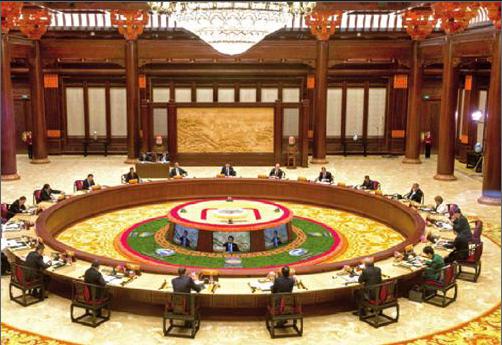APEC’S NEW VISION
2014-12-19ByYuShujun
By+Yu+Shujun

‘FTAAP,” “connectivity” and “innovation” were among the buzzwords during the Asia-Pacific Economic Cooperation(APEC) Economic Leaders Week (November 5-11) in Beijing and they will certainly become the keywords for the Asia-Pacific regions future development.
Revolving around the theme of Shaping the Future Through Asia-Pacific Partnership, this years APEC Economic Leaders Meeting focused on the three major topics: advancing regional economic integration; promoting innovative development, economic reform and growth; as well as strengthening connectivity and infrastructure development.
On November 11, after their annual meeting ended, APEC economic leaders released two important documents—the 22nd APEC Economic Leaders Declaration: Beijing Agenda for an Integrated, Innovative and Interconnected Asia-Pacific and the Statement on the 25th Anniversary of APEC: Shaping the Future Through Asia-Pacific Partnership.
“The two documents further define the directions, goals and actions of the regions development and mark the beginning of a new era of Asia-Pacific cooperation,” Chinese President Xi Jinping told the media at a press conference after the 22nd APEC Economic Leaders Meeting closed.
The latter is a commemorative statement—the first of its kind in the history of APEC—which “we believe will give strategic guidance to the APEC, consolidate its position and give full play to its role of leading and coordinating economic cooperation in the AsiaPacific region,” said Xi.
The 21 APEC member economies have a combined population of 2.8 billion, or 40 percent of the worlds total, generate 57 percent of the worlds GDP and contribute 48 percent to global trade. Facing the uneven recovery of the world economy, the Asia-Pacific has entered a new stage of development with both new opportunities and new challenges.
Xi said that APEC economic leaders have reached consensus that economic integration is the driving force behind the regions sus- tained strong growth in the long term.
Facilitating FTAAP
The APEC economic leaders endorsed a roadmap for promoting the Free Trade Area of the Asia-Pacific (FTAAP) process. This is “a historic step we took toward realizing the FTAAP,”marking the official launch of the process and demonstrating the confidence and determination of APEC members in advancing regional economic integration, said Xi.
The decision will raise integration to a new and higher level, benefit economies at various development stages across the Pacific Ocean and inject new energy into the growth of the region and all APEC member economies, the Chinese President said.
According to the APEC economic leadersdeclaration, APEC member economies will begin studying issues surrounding the FTAAP and will submit recommendations by the end of 2016.
“APEC has been called the ‘incubator of an FTAAP for years,” said Gao Hucheng, Chinas Commerce Minister at a press conference after the APEC Ministerial Meeting adopted the roadmap on November 8. “Launching the joint strategic study on FTAAP issues marks a progression of the APECs role from being an‘incubator to being a facilitator for the FTAAP.”
Trade and investment facilitation was set as the objective when APEC was established 25 years ago. In 2006, APEC economic leaders put forward the vision of an FTAAP, but it was not an objective that could be achieved immediately.
In 2010, the APEC Economic LeadersMeeting agreed to accept regional FTA negotiations—such as ASEAN plus Three, ASEAN plus six and the Trans-Pacific Partnership (TPP)—as potential pathways to the FTAAP and to make APEC an incubator of the FTAAP. But no real progress was made.
In recent years, all kinds of regional FTAs have thrived within the Asia-Pacific region. However, Gao said, due to different rules, standards and development levels of the regions economies, they failed to facilitate cross-border trade and investment.
A report released on November 7 by the Pacific Economic Cooperation Council(PECC), a non-governmental official observer of APEC, said a high-quality FTAAP that includes all APEC members would increase the size of the global economy by $2.4 trillion by 2025. The report also suggested that further liberalization via the U.S.-led TPP and the ASEAN-led Regional Comprehensive Economic Partnership (RCEP) should only add an estimated $223 billion and $644 billion to the global economy, respectively.
“Economies in the Asia-Pacific region hope the FTAAP can come to fruition as soon as possible after being incubated for years to bring greater benefits to companies and people in the region,” said Gao.
Roberto Azevedo, Director General of the World Trade Organization (WTO), believed that the FTAAP agreements would be compatible with multilateral trade systems and would complement the WTO. “Any move toward trade liberalization and against trade protectionism is a good move,” Azevedo told a press conference on November 8 in Beijing.
Michelle Bachelet, President of Chile, expressed her strong support for the launch of the roadmap to realize the FTAAP, in a speech at the APEC CEO Summit 2014 on November 9.
“Were certain that well build upon the many regional treaties already in place or under negotiation, such as the Pacific Alliance, the RCEP and the TPP,” said Bachelet.
“The various regional integration projects in the Pacific region are no zero-sum game,” she added.“On the contrary, they complement each other and reflect the variable geometry of a complex and diverse but ultimately highly dynamic and creative region, one that is setting the course and giving shape to the new century.”
Improving connectivity
APEC economic leaders also set the targets to enhance regional physical, institutional and people-to-people connectivity by 2025.
Despite the achievements in promoting connectivity within the region, challenges persist. There is still a disparity in the quality of and access to infrastructure throughout the region, and a large gap in the ability of institutions to promote connectivity due to various regulatory constraints or lack of capacity. On people-to-people exchanges, much work still needs to be done to ease barriers to interaction and mobility.
To tackle these issues, Xi said that the APEC members agreed to expand cooperation in infrastructure investment and financing, promote public-private partnerships, and thereby break the financing bottleneck.
As the Chinese saying goes, “to end poverty, build a road.” Infrastructure construction and connectivity are a prerequisite for regional economic integration.
“Just imagine the economic power that will be unleashed when the rest of the world becomes connected,” said Greg Boyce, Chairman and CEO of Peabody Energy from the United States, the worlds largest privatesector coal company, at the APEC CEO Summit on November 10. “China is a perfect example of what happens: Over the last 10 years, 600 million people have been moved up.”
A PwC report shows that Asias infrastructure market is going to grow by 7-8 percent annually over the next decade, to reach $5.3 trillion by 2025, or 60 percent of the worlds total.
China has a competitive advantage in infrastructure construction, and is willing to participate in international infrastructure projects and cooperation in connectivity, said Wang Zhenyu, an associate researcher with the China Institute of International Studies.
Right before the APEC Economic LeadersMeeting, Chinese President Xi announced on November 9 that China will contribute $40 billion to set up a Silk Road Fund at a dialogue meeting on strengthening connectivity with Chinas neighboring countries. The goal of the new fund is to “break the bottleneck in Asian connectivity by building a financing platform.”
The fund will be used to provide investment and financing support for carrying out infrastructure, resources, industrial cooperation, financial cooperation and other projects related to connectivity for those countries.
In terms of institutional connectivity, APEC economic leaders will strive to make progress in addressing issues of trade facilitation, structural and regulatory reforms, as well as facilitating transport and logistics.
In his opening remarks at the leaders meeting, Xi announced that China will donate $10 million for institutional development and capacity building for APEC and provide 1,500 training locations for developing APEC member economies to build their capacity in trade and investment.
APEC economic leaders also pledged to facilitate the movement of people across borders and the exchange of innovative ideas.
They set the goals for peopleto-people connectivity at achieving 1 million intra-APEC student exchanges per year by 2020 and increasing the number of student exchanges to developing economies, as well as 800 million APEC tourist arrivals by 2025.
At the APEC CEO Summit, U.S. President Obama announced that China and the United States have agreed to implement a new arrangement for visas: Student visas will be extended to five years and business and tourist visas will be extended to 10 years. Currently, visas between the two countries last for only one year.
According to a 2013 report by the World Tourism Organization and the World Travel & Tourism Council, visa facilitation could bring APEC 38-57 million additional international tourist arrivals by 2016. The inflow of additional international tourism receipts generated by these additional arrivals could reach $62-89 billion. The total number of jobs created as a consequence of this increase is estimated to reach 1.8-2.6 million.
Wang believed that regional connectivity will become a new pillar, together with trade liberalization, investment facilitation and technological cooperation, to prop up the economic integration of APEC.
New driving forces
Amid the uneven recovery of the global economy, economic growth in the AsiaPacific region has lost some steam. For the first half of 2014, the regions combined GDP growth only expanded by 3.9 percent, down from the 4.3-percent growth rate in the second half of 2013, according to a statement by Denis Hew, Director of the APEC Policy Support Unit, when releasing APECs latest Economic Trends Analysis report at a news briefing in Beijing on November 6.
The slower growth happened in both devel- oped and developing economies in the region, due to a number of factors including gradual recovery of developed economies, more subdued trade activities globally and domestic demand, said Hew.
In 2014, the Asia-Pacific regions GDP is estimated to grow 3.9 percent, 0.1 percentage point lower than that in 2013.
To achieve strong, sustainable, balanced and inclusive growth over the longer term, new sources of growth should be created.
APEC economic leaders reached an accord that the Asia-Pacific region should continue to deepen structural reform, strengthen innovative growth and promote closer cooperation in five pillars—economic reform, new economy, innovative growth, inclusive support and urbanization.
They agreed to convene a ministerial meeting on structural reform in 2015 to discuss issues including overcoming the middleincome trap.
Furthermore, they will to tap into the growth potential of emerging sectors such as the Internet economy.
Under this inclusive support pillar, they will strengthen cooperation on entrepreneurship and employment, the health sector, food security and safety, and sustainable agricultural development. Disaster prevention and mitigation, social responsibility, business ethics and anti-corruption efforts are also suggested, alongside an emphasis on the participation of women in the economy.
